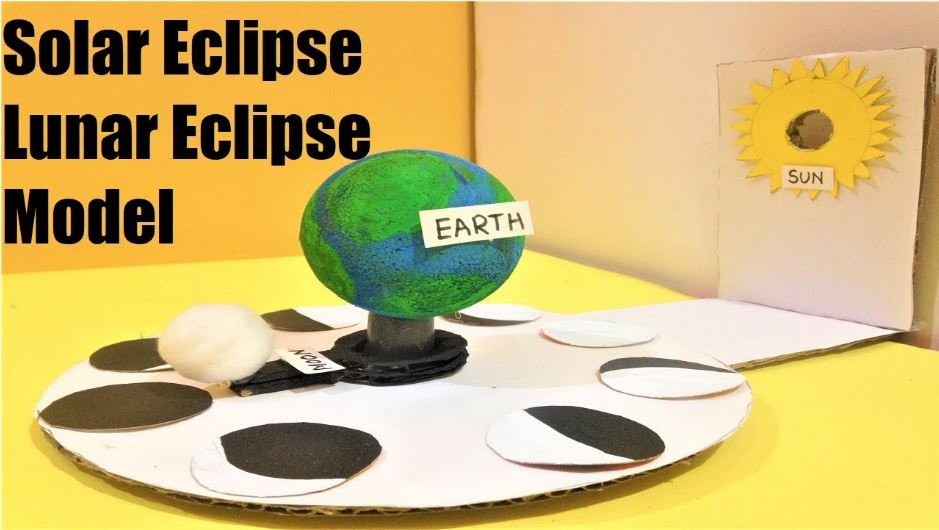Introduction:
A solar eclipse is caused when the earth passes through the shadow cast by the moon and partially or fully blocks the rays of the sun.
This can only occur when the sun, the moon and the earth are nearly aligned on the same line.
The lunar eclipse occurs when the moon passes directly behind the earth inti its shadow. This occurs when the three bodies are closely aligned.

Materials required:
- Cardboard
- Bangle
- Pencil
- Paint
- Paint brushes
- Newspaper
- Modelling cardboard
- Scissors
- Fevicol
- Small ball
- Cotton
- Sponge ball
- Coloured paper
- Markers
- Light source
You use the resource/tools page section to find the tips where you can buy these materials used at a reasonable cost.
Detailed Video Show How To Make SOLAR AND LUNAR ECLIPSE 3D WORKING MODEL FOR SCHOOL SCIENCE EXHIBITION PROJECT
In this project, we’ll create a dynamic moon phases model using a small white ball to represent the moon, colored paper to depict the various phases, a light bulb as the sun, a ball for the Earth, a DC motor for rotation, and a switch for control. Here are the steps:
Materials Needed:
- Small white ball (to represent the moon)
- White Paper Colored (for different moon phases)
- Cardboard sheets
- Light bulb (as the sun)
- A ball (to represent the Earth)
- Paints or markers (for decorating the Earth)
- DC motor with switch
- Power source for the motor (e.g., 9v battery pack)
- Wires and connectors (for the electrical connections)
- Glue or adhesive
- Small stick or wire (for mounting the Earth)
- Small gears or pulleys (optional, for mechanical advantage)
Building the Moon Phases Model:
1. Preparing the Moon:
Step 1: Take a small white ball to represent the moon.
Step 2: Use white paper to create various phases of the moon (New Moon, First Quarter, Full Moon, Last Quarter). Cut out and attach them to the cardboard using glue or adhesive as shown in the picture
2. Preparing the Earth:
Step 3: Decorate the ball (representing the Earth) with paints or markers to depict continents, oceans, etc.
Step 4: Mount the Earth on a stick or wire. You may need to use glue or adhesive to secure it in place.
3. Setting Up the Sun:
Step 5: Attach the light bulb in a way that it acts as the “sun” in your model. You can place it above the Earth.
4. Building the Base:
Step 6: Cut out a rectangular piece of cardboard to serve as the base. Attach the Earth and the sun to this base.
5. Adding the Rotating Mechanism:
Step 7: Attach a DC motor to the base of the model. Position it in a way that it can rotate the Earth.
Step 8: Connect the motor to a switch for on/off control.
Step 9: Connect the motor to a power source (e.g., battery pack).
Optional: You can use gears or pulleys to create a mechanical advantage and ensure smoother rotation.
6. Demonstrating the Phases:
Step 10: Turn on the motor using the switch. This will start the rotation of the Earth.
Step 11: As the Earth rotates, observe how the moon phases change relative to the Earth and the “sun.” This simulates the different moon phases.
7. Labeling and Detailing:
Step 12: Label each phase of the moon (New Moon, First Quarter, Full Moon, Last Quarter) on the respective phases.
Your moon phases working model with rotation is now complete!
This dynamic model provides a visual representation of how the moon’s appearance changes as it orbits the Earth. It’s an engaging educational tool for learning about the different phases of the moon with an added element of interactivity.
Questions and Answers:
- What is a solar eclipse?
A solar eclipse occurs when the moon passes in a direct line between the earth and the sun. The moon’s shadow travels over the Earth’s surface and blocks the sun’s rays.
There are primarily three types of solar eclipses.
They are total, annular and partial. If the umbra passes over you, it is the total solar eclipse, whereas if the penumbra passes over, it is a partial solar eclipse.
- What is a lunar eclipse?
Lunar eclipses occur once the moon and also the sun are on opposite sides of the world. This is most often during a full moon.
There are three types of lunar eclipses, they are penumbral lunar eclipses, partial lunar eclipses and total lunar eclipses.
- What is the distinction between a solar eclipse and a lunar eclipse?
When a solar eclipse occurs, the earth is aligned with both the sun and the moon. The three celestial bodies are almost in the same line.
Whereas, for a lunar eclipse, the earth is in the middle of the sun and the moon and they are on either side of the earth.
The solar eclipse occurs usually when there is no moon, and the lunar eclipse when the full moon cycle occurs.
- How often do eclipses occur?
Eclipses occur on an average at least two to four times a year. They are fairly numerous.
Although a total eclipse happens only once in a few hundred years. Eclipses are merely the shadow of one of the celestial bodies on the other.
Conclusion:
The video tells you how to create a working model that will exhibit both the solar and the lunar eclipse.
The materials used are mostly available and the time required to create the model is short. It is however extremely helpful in the understanding of the concepts of solar and lunar eclipses.

